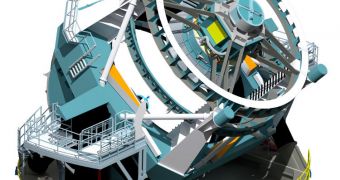Subra Suresh, the director of the US National Science Foundation (NSF), recently asked approval from the National Science Board (NSB) for advancing the Large Synoptic Survey Telescope (LSST) to the final design stage. Analysts expect that the large observatory will receive the necessary go-ahead.
One of the most important implications of this request is that receiving the approval will enable Surech to include LSST funding in upcoming budget requests the NSF will compile. The telescope will be very expensive to build, but its scientific returns will more than match investments.
The three-mirror telescope will feature a primary lens with a diameter of 8.36 meters, a secondary lens 3.42 meters across and a tertiary one sporting a diameter of 5 meters. This will enable the observatory to conduct wide-angle observations of its targets.
Expected to see its first light in the fall of 2015, the LSST will be built at El Peñón, in Chile, at an altitude of 2,660 meters (8,727 feet). According to its technical specifications, it will conduct observations at wavelengths between 320 and 1060 nanometers (nm).
This means that it will be able to detect optical light, plus small portions of near-infrared and near-ultraviolet portions of the electromagnetic spectrum. LSST will be able to survey the entire night sky twice every 7 days.
The decadal survey in astronomy and astrophysics that the US National Academy of Sciences released in 2010 listed this telescope as the first priority for ground-based observatories. NSF is working closely with the US Department of Energy and certain private contributors on the project.
“LSST will provide an unprecedented view of the sky while leading the emerging discipline of data-enabled science. The project will foster international collaboration and offer unique methods for discovery in this new age of Big Data,” Suresh explains.
A 3-billion pixel digital camera will be the main instrument on the Large Synoptic Survey Telescope. It will be able to detect moving objects, and establish their trajectories and speeds, while at the same time keeping track of the location of billions of galaxies.
“LSST will transform how scientists detect and analyze astronomical events. The potential to deepen our understanding of the universe and its constituents, from distant exploding stars to nearby asteroids, is enormous,” adds expert Edward Seidel.
The scientist, who holds an appointment as the assistant director of the NSF Mathematical and Physical Sciences Directorate, says that the total construction cost for the LSST is $665 million, of which 70 percent will be provided by the NSF, 6 percent by the DOE, and 6 percent by private contributors.

 14 DAY TRIAL //
14 DAY TRIAL //